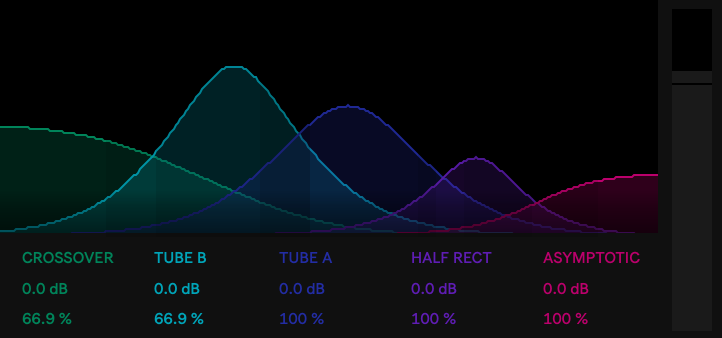Device Details
Overview
| Name | Version: | Spectacle 1.0 |
| Author: | OspreyInstruments |
| Device Type: | Audio Effect |
| Description: | This is my take on a parallel band saturation plugin with a similar name. I quite like the dev of the original, so again, not trying to harm their business in any way, I just thought it is an interesting concept, and would make for a fun project. Plus it is free. I also have no intention on building this out further to include all of the MS/stereo features of the original. So what is it? Basically, it is parallel EQ bands, and for each, the resulting signal is subtracted from the original to create a difference signal (or a signal that is exclusively the area under the curve of that band). Building on this concept, this creates shelves and bells (gaussian curves) that isolate the signal in that band, similar to crossover filters (BPFs), only, with the more gradual shapes of the bells and shelves. Each band can be boosted into its own saturation circuit, and finally, is summed back with the dry signal. With this architecture, only the boosted parts of the signal are saturated, and naturally, you can emphasis different frequency response of the saturation. Saturation Algorithms: Tube A - This is a polynomial waveshaper that creates a balance of even and odd harmonics. The original was tuned to sound similar to a Leslie 122 amp, but this has been modified, replacing the output section with a simplified hysteresis model, intended to capture some of the magnetic affects of the output transformer in a tube amp. I find this model to be pleasantly round, gentle and woofy. Tube B - This is an asymmetric trigonometric waveshaper built on two tanh() functions that respond differently above and below the zero crossing. This is much crisper and buzzier, and when driven, can cut off a section of one of the peaks. Crossover - This models the crossover distortion of a class B amplifier. This is probably my second favourite algo (after Tube A). I like it a lot on high and mid-high frequencies to add a bit of grit or fuzz. Tanh() - Vanilla hyperbolic tangent waveshaper, probably the most common of all saturation algorithms. It smoothly rolls off signal approaching the boundaries (-1, 1) and squares off to produce odd harmonics when driven. It sounds quite rounded and pleasant, and is also very CPU efficient. Asymptotic Limiting - This is another odd-symmetrical waveshaping function, similarly shaped to tanh(), however, it is even gentler and more rounded, offering more headroom than tanh() for the same gain. Hard Clipping - What it says on the can. It lops off the peaks. This on is x4 oversampled to reduce aliasing. It's a little buzzy at higher gains, but sometimes can be exactly what you need. This is especially true when you want to shave some spikes off of highly transient program material, be it drums, or even a full mix. Wave Folding - When the peak is passed the -1,1 amplitude threshold, it is reflected back onto itself, with the folded section being inverted. This creates very sharp transition regions at the reflection boundaries, making for a very crispy distortion. Again, utilized x4 oversampling to try and combat aliasing for this one. Full-wave Rectifier - This takes the absolute value of the signal. In practice, this means the negative portion of the signal is flipped positive, the way a full bridge rectifier would do in hardware. This time, the reflection boundary is around the 0 axis, and forms a similarly sharp transition that creates lots of high frequency harmonics. Half-wave Rectifier - This is equivalent to a single diode rectifier. That is to say, the negative portion of the signal isn't flipped this time, it is just discarded. This shouldn't produce as many higher order harmonics as the full-wave rectifier, and it excels at creating even order harmonics due to the asymmetrical mangling. Band controls: Each band can be moved left and right (frequency axis), boosted, or have the Q/slope changed via the normal Ableton EQ control methods. For each band, an input gain can be applied to boost into the saturation stage (post difference EQ). There are also band-level mix parameters to pocket the saturation signals into the dry signal. Bugs: When loading the device the first time (dropping into the rack), the graphical EQ GUI doesn't show up correctly. There are a lot of overlapping transparent layers that don't seem to load properly, but clicking it to drag up a band seems to correct this. CPU usage is also on the higher side. Anyone with an underpowered system (such as mine) may want to test it out first before "paying" for it (if that's something you were considering). I'd prefer to know that it is stable on your system before you drop any money. There are ways to donate afterwards if you are so inclined. And of course, this is completely optional! It is completely free to use for anyone who wants to! |
Details
| Live Version Used: | 10.1.18 |
| Max Version Used: | 8.1.5 |
| Date Added: | Apr 23 2023 06:34:14 |
| Date Last Updated: | No Updates |
| Downloads: | 0 |
| Website: | https://ko-fi.com/s/a36b72df71 |
| ⓘ License: | None |
Average Rating
Log in to rate this device |
-n/a- |
Comments
outstanding work!!!
Posted on April 23 2023 by AYA |
Report Issue
love it!
Posted on April 24 2023 by FreddyFingaz |
Report Issue
this is really good. I'd love to add haas or simple stereowidth and also panning as one of the effect selections
Posted on July 21 2023 by hatyn |
Report Issue
Login to comment on this device.
Browse the full library